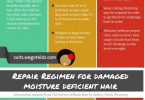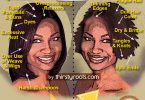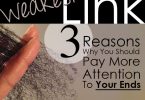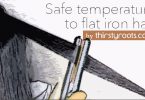Before we get into traction alopecia symptoms, lets first learn what is this hair loss condition. Traction Alopecia hair loss is caused by extensive damage to the dermal papilla (hair papilla at the base of the follicle shown in the diagram) and the follicle by constant friction of pulling or tension over a long period of time.
Signs and symptoms of traction alopecia
- Did you ever or do you have to take a pain reliever after getting your braids done?
- Does your scalp get sore where you wear your ponytail?
- Has your hairline receded considerably over the years or recently ?
- Do you notice some thinning or hair breakage around your hairline?
- Do you notice little bumps and redness around your hairline?
- Have you been wearing cornrows or braids your whole life?
- Do you have dreadlocks that are long and thick?
- Do your hair extensions break off?
- Do you have a hair system that is attached with clips or links?
Source: Hair Loss Condition: Traction Alopecia by Naomi Mannino http://www.hairloss.com/home/hair-loss-condition-traction-alopecia.html
Traction Alopecia can be a permanent hair loss condition if not detected before irreplaceable damage occurs. On the other hand it is reversible if noticed and treated in the early stages.
So let’s try to prevent this type of self-inflicted hair loss by recognizing and changing these common hairstyles and styling practices:
- Tight Braids: If it hurts, its too tight – do not go through pain to get neat edges while wearing any type of braids. The result could leave you with no hair along the hair line.
- “Overprocessing” the Hair: Chemical treatments such as dyes, relaxers, bleaches, and texturizers reduce the strength of the hair’s keratin structure. Afro texture hair is already fragile and chemicals only make it weaker, which can result in hair loss after just brushing or combing. If you overprocess, you can suffer serious hair loss and breakage.
- Weaving and Wigs using Glue: If you are using hair glue to put hair extensions in your hair, stop. It’s too risky. If the glue is not applied correctly, your hair will come out during the take down process and possibly permanently.
- Leaving Braids or Weave in Too Long: If your braids are hanging on thin strands and new growth can be seen a mile away, your braids are long overdo. The weight of the braids can pull your hair out. Do not keep braids or weave in your hair longer than 2 months, the less time the better.
- Tight Ponytails and Pulled Back Hairstyles: You see the effects of these hairstyles in little girls. Their edges become thin with much breakage because the choice hairstyle is cute little pigtails almost everyday. A key note is to only wear ponytails for short periods of time and not often. Another note is just to not pull hair back too tight.
Traction Alopecia is most common in African American women and children. We have to change some styling practices that leads to this hair loss. Even some professional stylist and braiders do not understand how important it is to be gentle with our hair.
Just note that the hair loss condition of Traction Alopecia is a serious matter and unfortunately no medical treatment is available for severe cases outside of getting hair transplants. So do not abuse your hair.








Too late for me, but glad there are resources like these for everyone else.
Thanks for sharing information. It was happening to me before to hurt my hair from braids that braider didn’t bother to care. And hairstylist did over processed relaxer to burn my hair. I don’t understand that both are professional; they should know that. BUT they don’t care?
That is good thing to have natural hair since almost 2 years after I was fed up with relaxer and braid.
Can you reverse traction alopecia at an early stage?